- Created by Peter Scott, last modified by Emma Day on May 20, 2022
Written by Emma Day
Overview
Medical-Objects Explorer Online is a web‑based solution designed for allied health practitioners that makes creating and managing clinical correspondence a breeze. At the click of a button you can seamlessly send and receive results from your personal desktop, laptop or tablet. You can also send PDF documents to recipients in seconds.
Explorer Online is an efficient practice management system useful for dietitians. It can be used to send out custom patient questionnaires or self-assessments, record clinical consult notes, complete patient assessments, send doctor letters and receive confidential patient files.
This article will cover the basic functionality of Medical-Objects Explorer Online for dietitians. If you have any questions or require any further information, please contact the Helpdesk on (07) 5456 6000.
Requirements
Explorer Online was designed to run on desktops, laptops and modern tablets running Windows, MacOS or Linux. Mobile phones are not currently supported.
Please take note of the browser requirements below.
Supported Browsers
- Microsoft Internet Explorer 11
- Microsoft Edge
- Chrome
- FireFox
- Opera
- Safari 8+
Logging in and Out
When first loading Explorer Online you will be presented with a login screen. Simply enter in your username and password and click Log In to proceed.
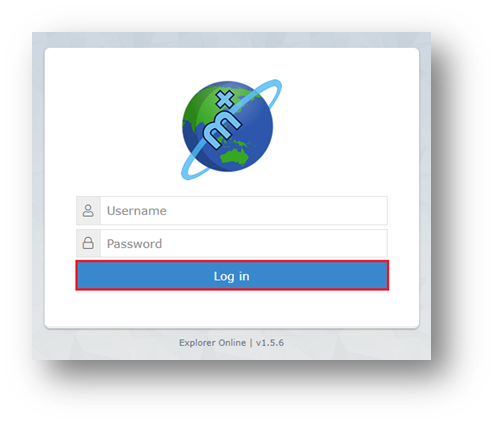
After entering in your username and password Select Provider.
Note: This is only available if you have multiple provider numbers.
A list will appear with Provider’s name and provider number associated with the corresponding location.
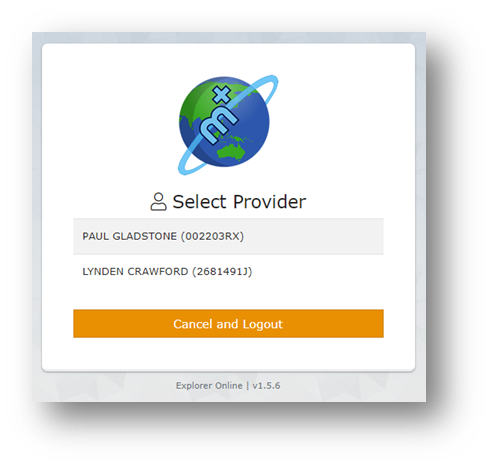
Once logged in, the User Menu will display the server you’ve logged into and also which provider you selected at login.
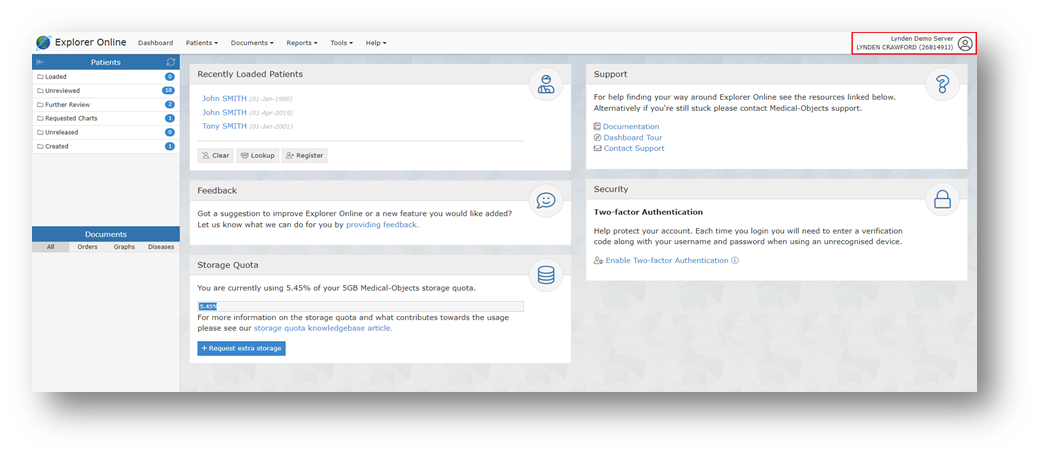
When you click on the User Menu a drop down will appear with menu options related to your user account. You can edit User Settings, Change Provider, Enable Two-factor Authentication, Change Password and Logout.
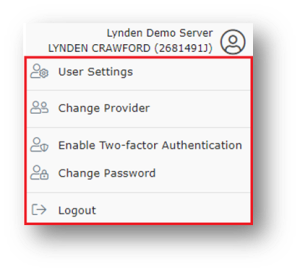
Note: you will be automatically logged out after 10 minutes if inactivity. You can change this via the User Settings option in the User Menu.
Email Notifications
Tip! Please contact us to enable this feature on your account.
Click User Settings from the User Menu if you would like to enable email notifications.
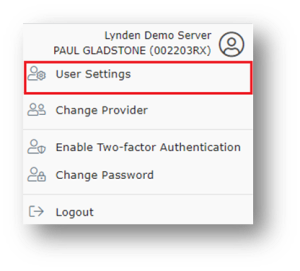
Next, click Document Notifications and enter the email address that you want to receive the notifications to.
Set up the Interval of how often you want to receive email notifications - it's recommended once an hour or every 4 hours - and select Save.
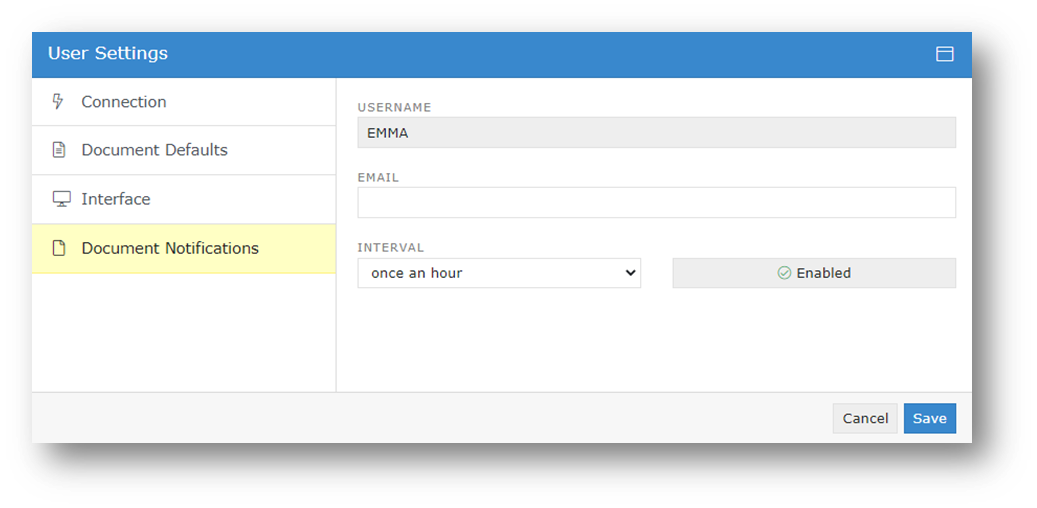
Dashboard Layout
The Dashboard is the default page that will appear once you have logged into Explorer Online. The Dashboard is split into three sections: Navigation Menu, Sidebar and the main content area.
Tip! The dashboard includes the option to complete a tour found under the help tab.
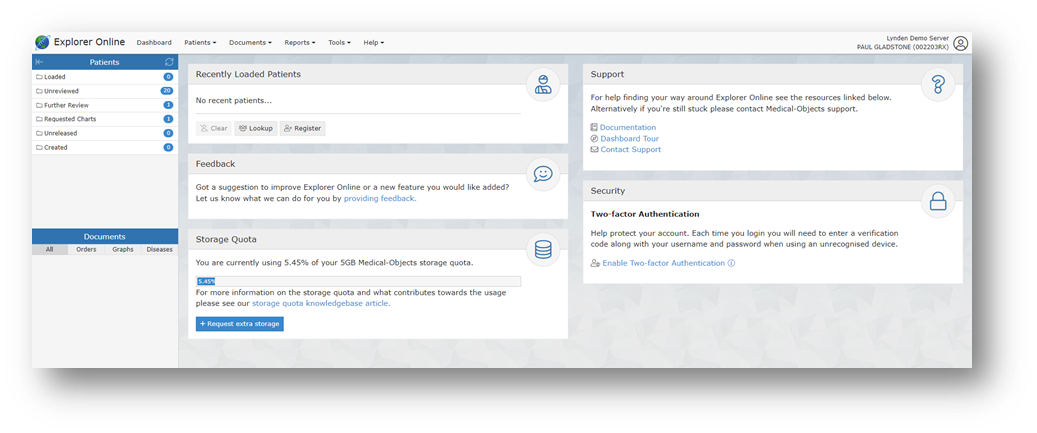
Navigation Menu
This is the main Navigation Menu. The menu is dynamically built up based on what features your server has enabled and what permissions your user account has. If a menu item is missing you may need to call the Helpdesk (07 5456 6000) to correct your user permissions or enable a server feature.

Sidebar
The Sidebar is a feature that allows you to access and manage your patient documents. The Sidebar is split into two sections: Patients and Documents.
If you're using Explorer Online on a smaller screen you have the option to collapse the sidebar by clicking the collapse icon (![]() ) found on the left side of the Patients header. You can then expand the Sidebar again by clicking the expand icon (
) found on the left side of the Patients header. You can then expand the Sidebar again by clicking the expand icon (![]() ).
).
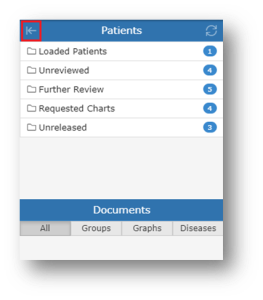
Patients
The Patients section of the Sidebar consists of individual folders which contains patient documents. The folders will list each unique patient that has a document for that folder. The count to the right is the number of patients in the folder and not the number of combined documents.
Hovering over a folder will reveal a grid icon (![]() ). This button will load all the documents in that folder into a grid. From there you can then perform bulk actions on the documents such as printing or forwarding to another provider.
). This button will load all the documents in that folder into a grid. From there you can then perform bulk actions on the documents such as printing or forwarding to another provider.
To refresh the contents of the folders simply click the refresh button (![]() ) in the title bar.
) in the title bar.
Loaded Patients | Contains any patients you've done a lookup on or retrieved all documents for. You can remove a patient from this list by clicking the remove icon ( If you want to clear the folder and remove all patients you can click on the clear icon ( |
Unreviewed | Contains patients that have unreviewed documents. Selecting documents from this folder will give you the option to mark the document as reviewed. |
Further Review | Contains patient documents that have been parked. A document can be parked by clicking the Park document action button.
Documents in this folder can only be accessed by the provider who made the original Park request. To remove a document from this folder, click the Unpark document action button.
|
Requested Charts | Contains patient documents with the requested chart status. A document can be moved to the Requested Charts folder by clicking the Request Chart document action button.
Any user in your practice’s Explorer Online software, who has the granted permissions to view results, can access documents in this folder. For more information on setting user permissions, see our Explorer Online Admin Guide or please contact the Helpdesk on (07) 5456 6000. Practices can decide how to use this feature in their own workflows. For example, a dietitian can use this option when they receive a referral and then clicks Request Chart so that admin staff can be ready with the patients’ information upon booking in an appointment. Upon completion of the workflow with that document, staff can then select Cancel Chart document action button to remove it from the Requested Charts folder.
|
Unreleased
| Contains patient documents that have not yet been released. Documents in this folder can either be released or deleted.
An unreleased document will have the following red text in the document title to indicate that it has not yet been released.
Unreleased documents are created by ticking the For Approval Before Delivered option when sending a document. |
Created | Contains a recent list of documents that you have created, this includes both progress notes and documents that you have sent. You can clear this folder by hovering over it and clicking on the Clear Folder button ( |
Documents
The Documents section will list all the documents for the selected patient that correspond to the folder the patient is in. For example, if you select a patient in the Unreviewed folder, all unreviewed documents for that patient will be listed.
Hovering over the Documents section will reveal a grid icon (![]() ). This button will load all the documents listed into a grid. From there you can then perform bulk actions on the documents such as printing or forwarding to another provider.
). This button will load all the documents listed into a grid. From there you can then perform bulk actions on the documents such as printing or forwarding to another provider.
Abnormal results will show as red in the documents list.
Managing Patients
Registering a Patient
To register a patient, select the Patients button in the top navigation and then click Register Patient on the dropdown.
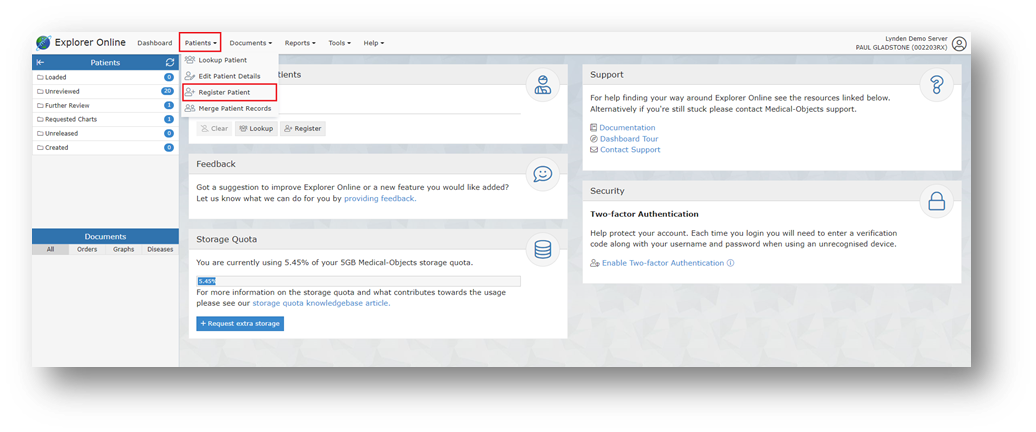
Once clicked, a window will pop up with text fields to input patient information, as seen in the screenshot below.
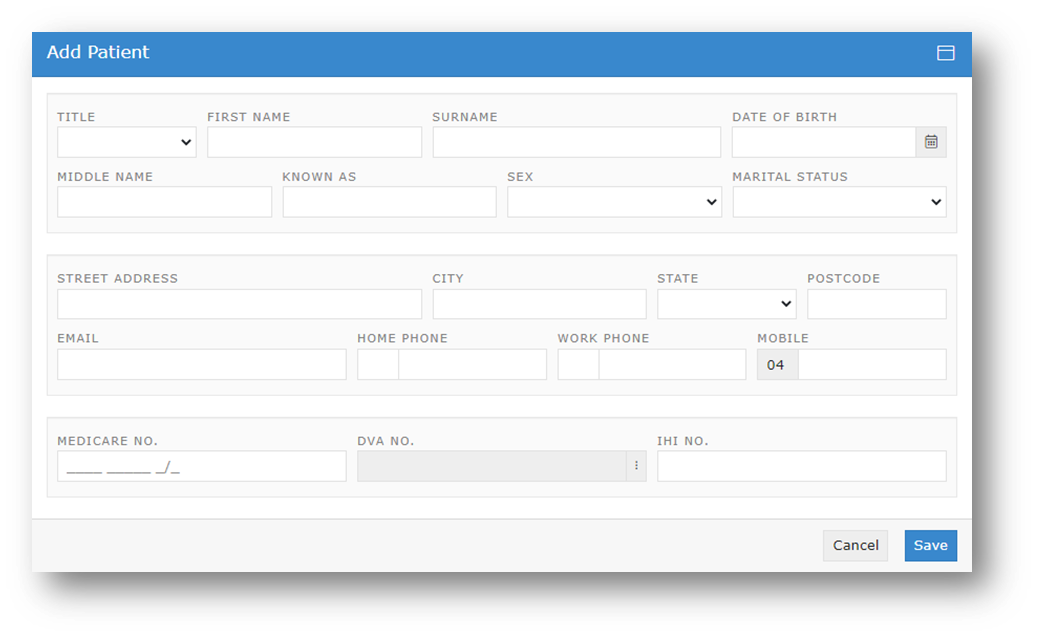
The required fields for registering a patient are Surname, First Name, and Date of Birth. While they are the only required fields, it's suggested that you fill as many of them out as possible, so you have as much information on documents as possible.
Editing a Patient
To edit a patient, go to the Patients dropdown in the top navigation bar, and then click Edit Patient Details.
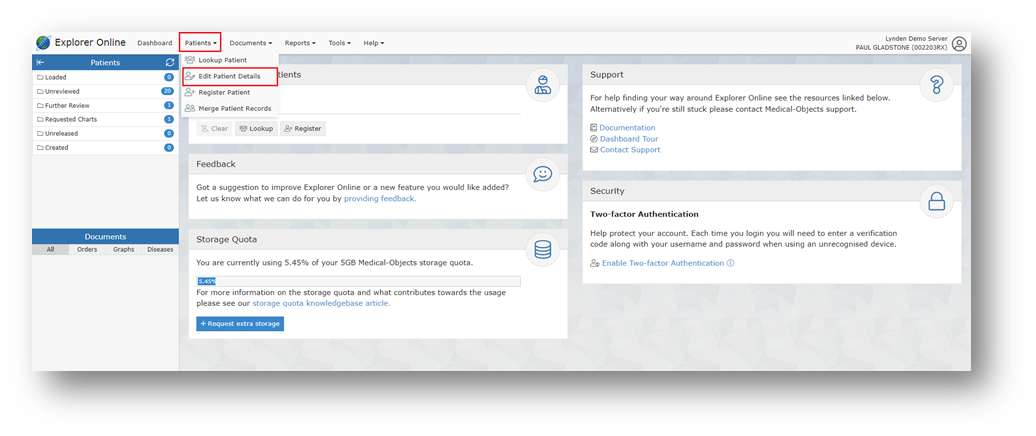
This will take you to the Patient Lookup window. The patient lookup window is used to search for current patients that your practice has previously created with Explorer Online. You have three different options in which to search for, their name, ID or lab number. You can change these on the dropdown to the right of the search field. You can then type a search term into the text field, press the Search button and if all is well, you will see your patient.

Clicking on the information icon (![]() ) will bring up the client's details. An example of the layout of the client detail's is shown below.
) will bring up the client's details. An example of the layout of the client detail's is shown below.
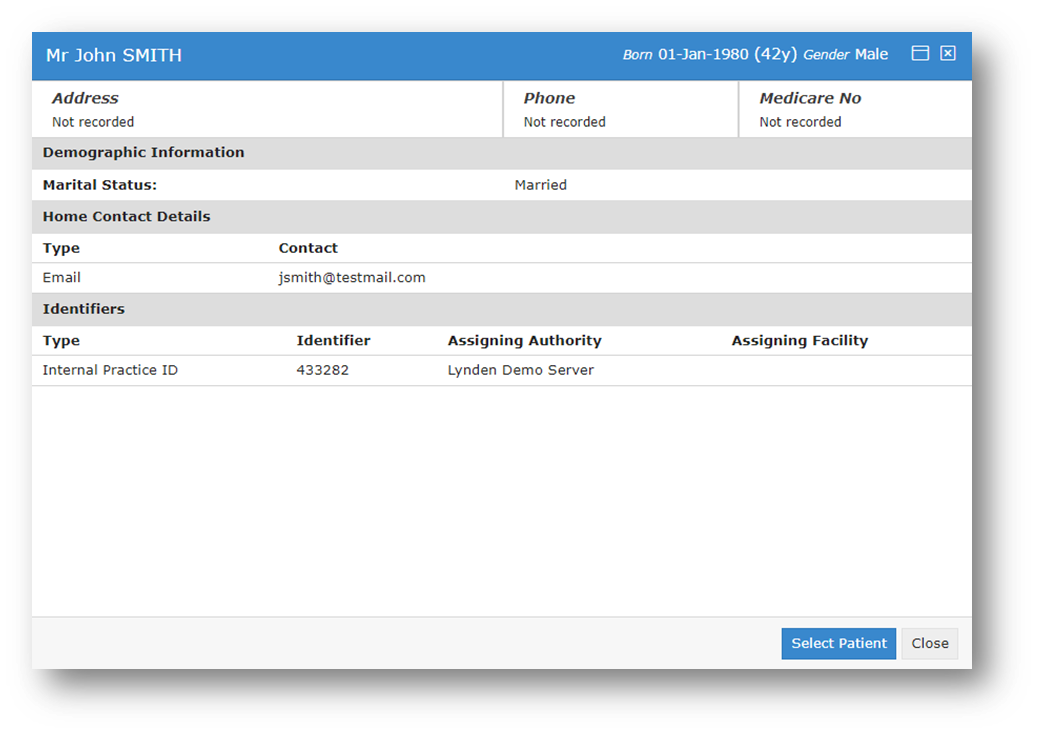
Once you have found your patient, you can then select the patient you wish to view, and then you will see the edit screen. Fill out the fields that you wish to change or add, and then click the Save button.
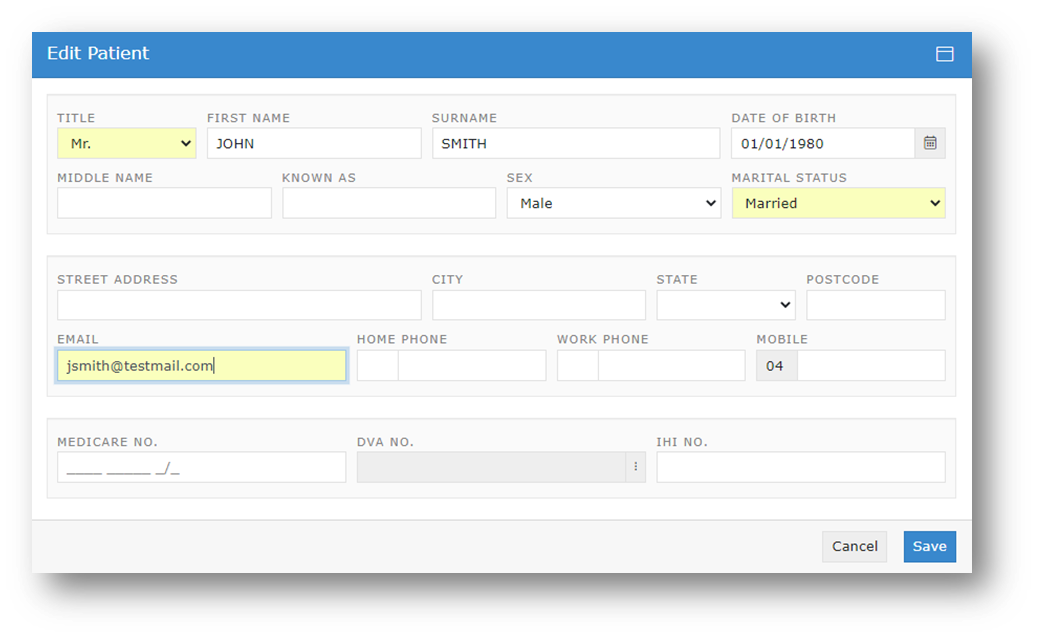
Merging Patient Records
To merge patients, open the Patients tab in the Navigation Menu then select Merge Patient Records.

Click the Find Patient 1 and search via the Patient Lookup. Ensure the correct patient is chosen and then follow the same steps for Find Patient 2. Before merging, make sure their details are the same. Choose which patient file is going to be the master by selecting the corresponding circle.
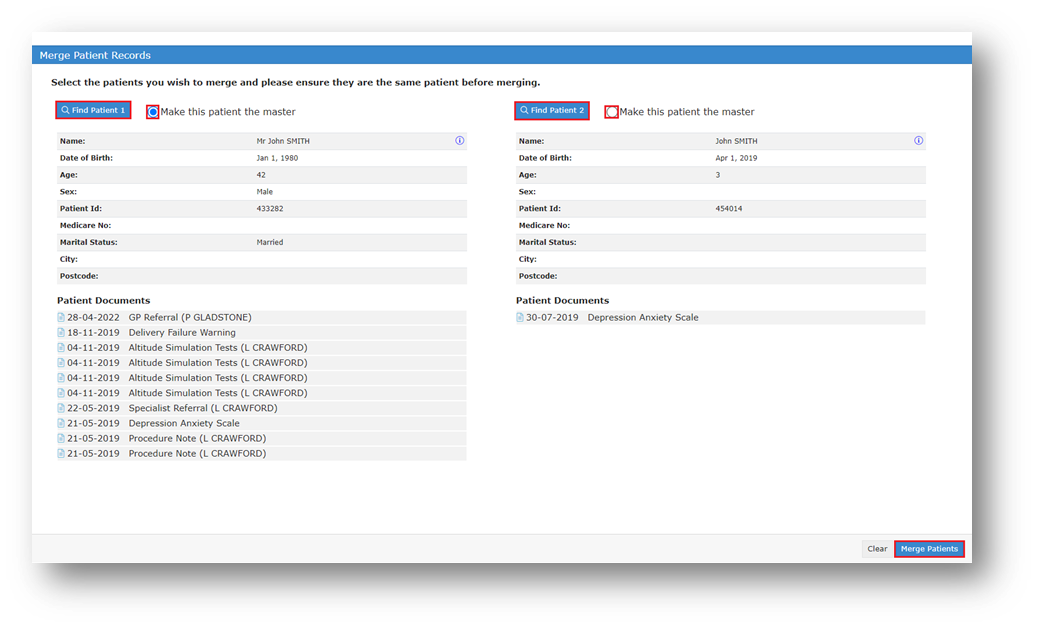
Viewing Documents
To view a document in a patients’ file, in the sidebar ensure the patient and document are highlighted.
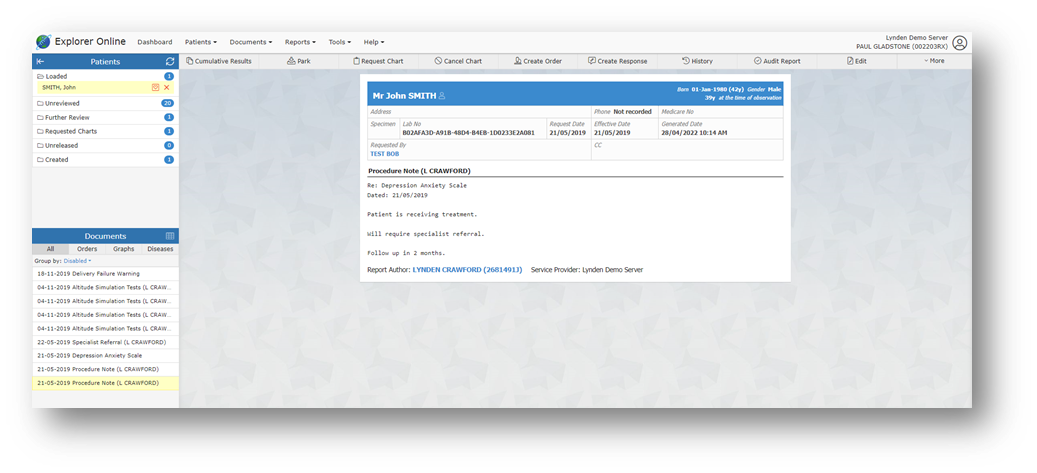
Tip! Pressing the space bar while viewing a document will scroll the document and then move to the next in the list.
Document Actions
The actions are found below the Navigation Menu.
Cumulative Results | Allows you to compare the patient’s scores after they have submitted the same survey multiple times. Click the total check box on the left-hand side to graph the results over time. |
Park | Adds the document to the Further Review sidebar folder. |
Unpark | Removes the document from the Further Review sidebar folder. |
Request Chart | Adds the document to the Requested Charts sidebar folder. |
Cancel Chart | Removes the document from the Requested Charts sidebar folder. |
Create Response | Brings up the Send Document form with the patient, ordering provider and copies to fields pre-populated from the document. |
History | Loads the transaction history of the document. |
Audit report | This button shows the selected documents audit log. |
Edit | Editing the document allows the addressing details, document details, and parts of the written document to be altered. |
Forward | Found under the More button, it allows you to forward the document to another provider. |
Found under the More button, it allows you to print the document. | |
Release | This button is only visible for unreleased documents. It will release the document and send it to the addressed provider/s. |
Delete | This button is only visible for unreleased documents. It will delete the unreleased document. |
Mark as Reviewed | This button is only visible when viewing a document from within the Unreviewed sidebar folder. It will mark the document as reviewed. |
All Documents | This button will show up when viewing a document from any sidebar folder except the Loaded Patients folder. When clicked it will load all the documents for the patient of the currently selected document. |
Viewing Documents in Grid
To list documents in a grid allowing for bulk actions you can simply click on the grid icon (![]() ) in the sidebar from either the documents section or when hovering over each folder.
) in the sidebar from either the documents section or when hovering over each folder.
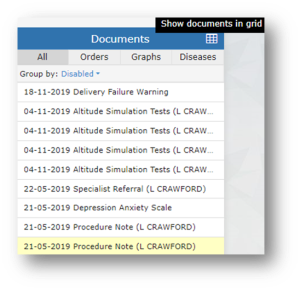
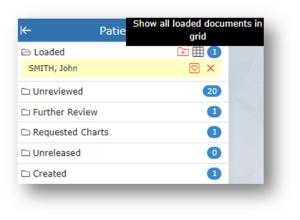
Tip!
- You can hide or show columns via the grid menu (
 ) which can be accessed by clicking the far button on the grid.
) which can be accessed by clicking the far button on the grid. - You can drag to re-order columns. The position of columns will be remembered.
- You can reset the grid layout by choosing Reset View from the grid menu.
- You can filter the documents in the grid by clicking the Add filter

Bulk Actions
You can select multiple documents in the grid and then perform an action on the selection. Currently the bulk actions available are:
- Exporting to CSV (this exports the transaction details and not the document itself, useful for auditing purposes)
- Printing (this can be sent to a printer or saved as a single PDF)
- Forwarding (sends document/s to chosen provider)
Making Documents as Reviewed
Documents that appear in your Unreviewed sidebar folder will need reviewing so that the sender of the document receives an acknowledgement.
Marking a document as reviewed can be done one of two ways. Both methods will only be accessible if you're viewing the document from within the Unreviewed sidebar folder.
Clicking on the Mark as reviewed document action button.
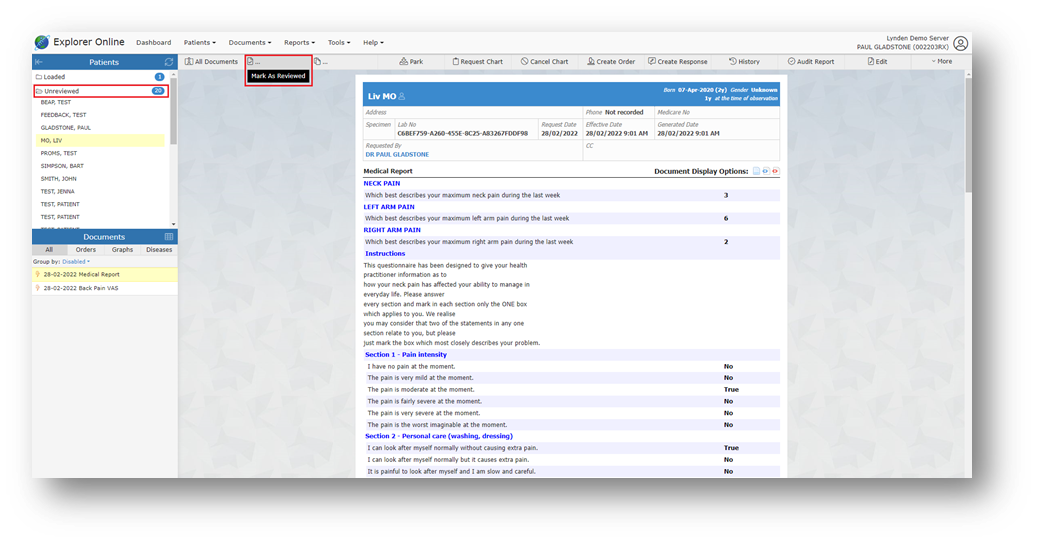
Navigating to the next document in the Unreviewed folder. A pop-up window will appear and this will prompt you with a few options.
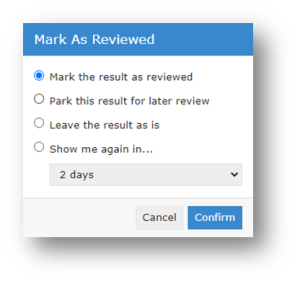
Document Actions
Found on the Navigation Menu the Documents tab is split into three different sections: Send; Create; and Manage.
Examples of how documents can be sent or received include:
- sending letters to the patient’s doctor after care plan appointments
- sending/receiving reports or progress updates to/from any other health professionals the patient is involved with (E.g. their paediatrician, psychologist, GP, occupational therapist etc.)
- sending/receiving patient questionnaires or self-assessments to/from the client
- sending/receiving any other type of document, PDF or image file
Tip! A clinician is required to be setup with Medical Objects to be able to receive incoming documentation. Being setup to receive with Medical Objects is quick, simple and also free – completed by either filling out an online form or calling the Sales team. The setup time takes about 10 minutes.
Creating documents in Explorer Online is useful for dietitians to write progress notes, use patient assessments and send out custom patient questionnaires.
Using the template editor is quick and easy to design commonly used documents like doctor letters, initial assessments, DVA reports and review progress notes.
Provider Lookup
The Provider Lookup feature allows you to easily search details and check if a provider is routable (setup to receive sent results) before you send a document.
To access the Provider Lookup feature, click on the Tools tab, then click Provider Lookup.
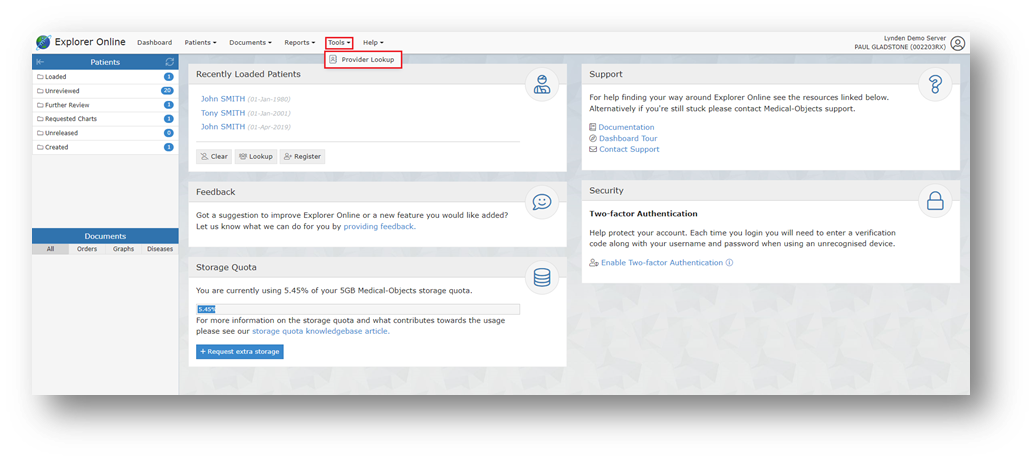
Enter the details of the provider in the search box, enter the surname first if you are searching by the Name search type. Press the Search button or hit the enter key to load results.

You can check to see if the provider number is routable by looking for the green globe in the Name column.

Tip! Having issues finding a doctor? Try the following:
- Change the search type to Organisation, and search for the practice name.
- Try a partial name search if you're unsure of the full name. "Bob Johnson" can be found by searching for "John B" or "Jo Bob".
- If the doctor has a space in their surname, try leaving out the space. For example, "Bob Von Doctor" can be found by searching "VonDoctor" as the surname.
You can also complete the Provider Lookup when completing the Addressing Details when sending a document (see below).
Sending a Text Document
To send a document, you can click the Documents → Document (Under Send) in the navigation bar at the top.
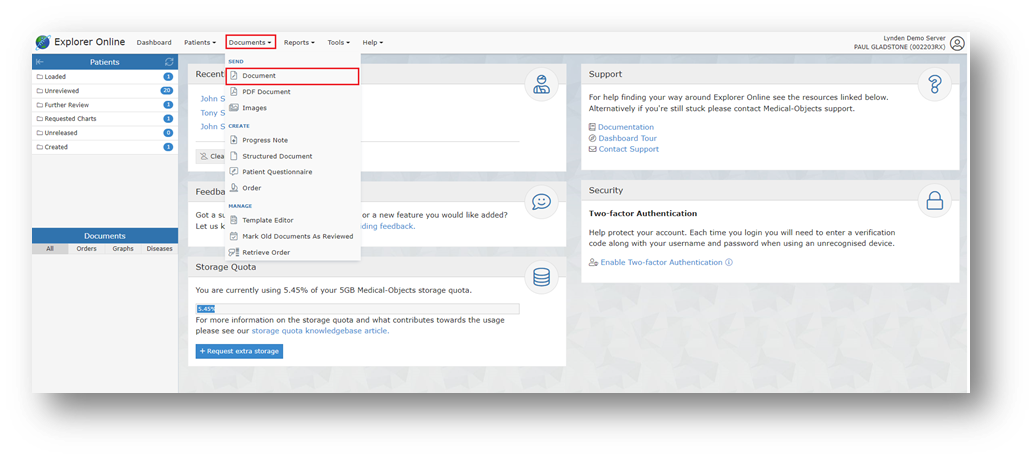
Most of filling out the document information is done automatically. If you have a patient selected in the Patients Sidebar then the Patient Details will already be filled out. If not, then you can click the Find button in the Patient Details section and find the patient details you need. You can also Add a patient on this screen, if the patient whose document you want to send isn't in the system yet.
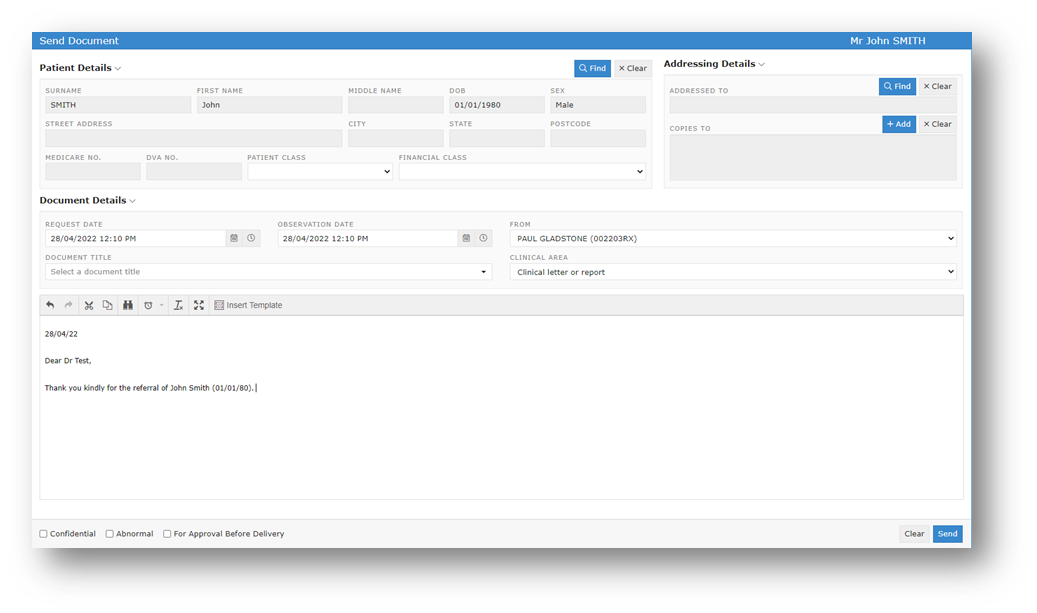
Addressing Details
To add a practitioner to send to, you can go across to the Addressing Details section. To add providers, click the Find and Add buttons, to either add the main provider, or to send copies to certain providers. This button will take you to the Provider Lookup window where you can find the providers you wish to send to.
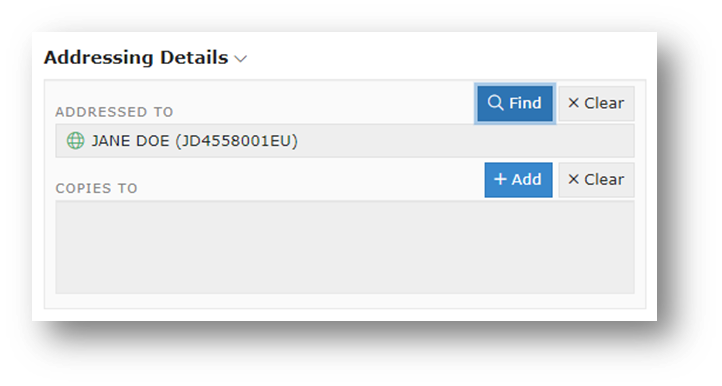
Document Details
You can then fill in the Document Details section with the specific details of your document. One of the special additions is the use of Templates, which you can click the Insert Template button to quickly add content to your document.

Tip! You can make the text editor section full screen by clicking on the expand toolbar button.
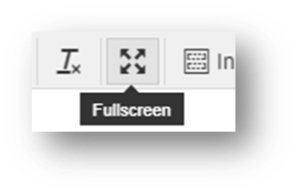
Unreleased Documents
An unreleased document can be thought of as a draft before sending the document. You may want to keep it in your system, but not send it off to the Addressee. If this is the case, then you can click the For Approval Before Delivery button in the bottom right of the Send Document screen.

Once For Approval Before Delivery has been selected a preview of the document will appear with a clear reminder in red next to the document title.
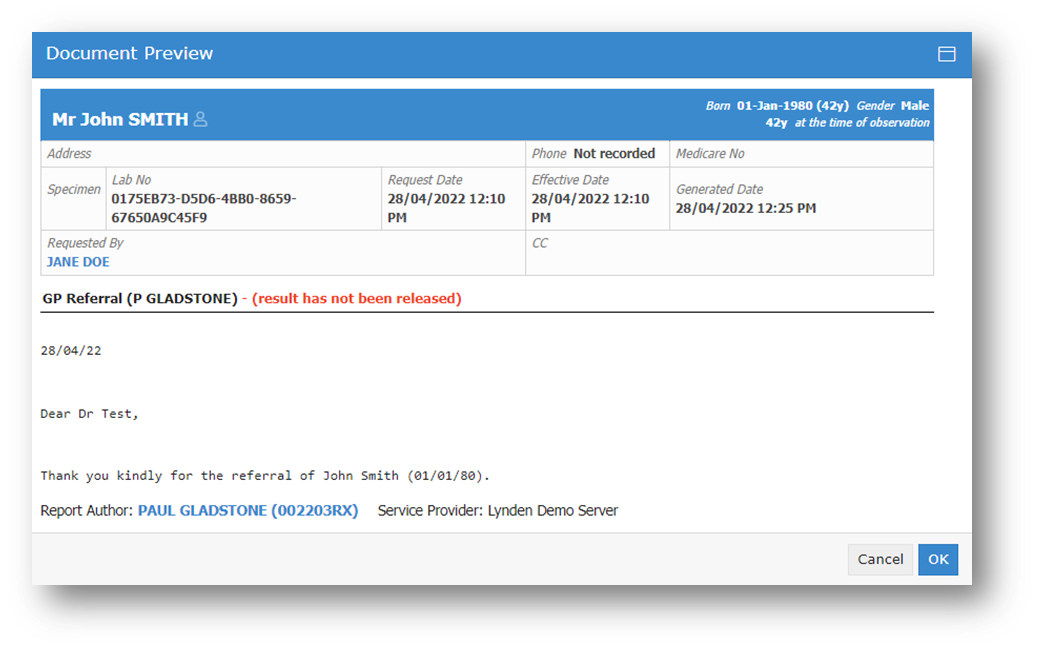
This will then save it into the Unreleased folder in the Patients section of the Sidebar.
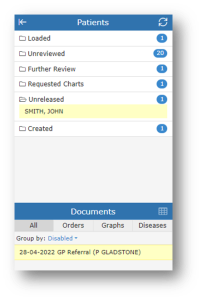
Sending a PDF Document
Sending a PDF document is very similar to sending a plain document. The main difference is that you aren't sending text, you are sending an attached PDF file. All of the Addressing and Patient detail setting is the same, the main difference is in the Document Details, where you normally would type in the content, there is now a PDF Viewer.
To send a PDF document, you can click the Documents → PDF Document (Under Send) in the navigation bar at the top.

To open a PDF, click the Browse button:

Tip! You can make the PDF preview full screen by clicking on the full screen toolbar icon.
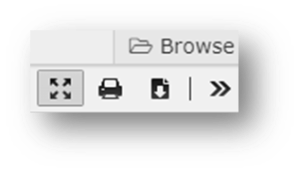
To send the PDF document, simply hit the Send button once all the information has been included.
Sending a Document with an Image
To send images you can click the Documents → Images (Under Send) in the navigation bar at the top.

To add the images, you would like to send, click the Browse Images button. To send the images, click the Send button once all the information has been included.
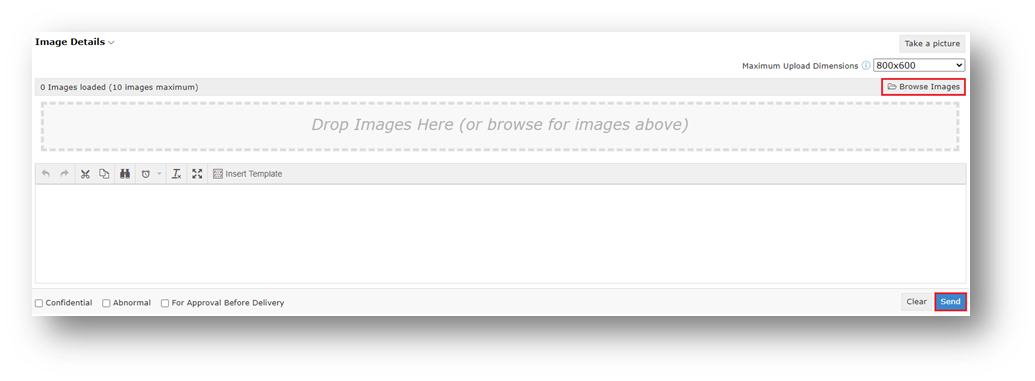
Sending a Work/RTF Document
Currently on Explorer Online it's only possible to send a plain text document OR a PDF document. If you wish to send a Microsoft Word document or any other format you have the option to save the document as a PDF (for example from Microsoft Word) and then send it as a PDF if you do not have the Word Plugin.
We're currently looking into adding the ability for sending other document types through Explorer Online.
Creating a Progress Note
A Progress Note is an internal document for a patient that is stored in the patient's file. You can create a Progress Note for a patient from the Documents menu in the top navigation.
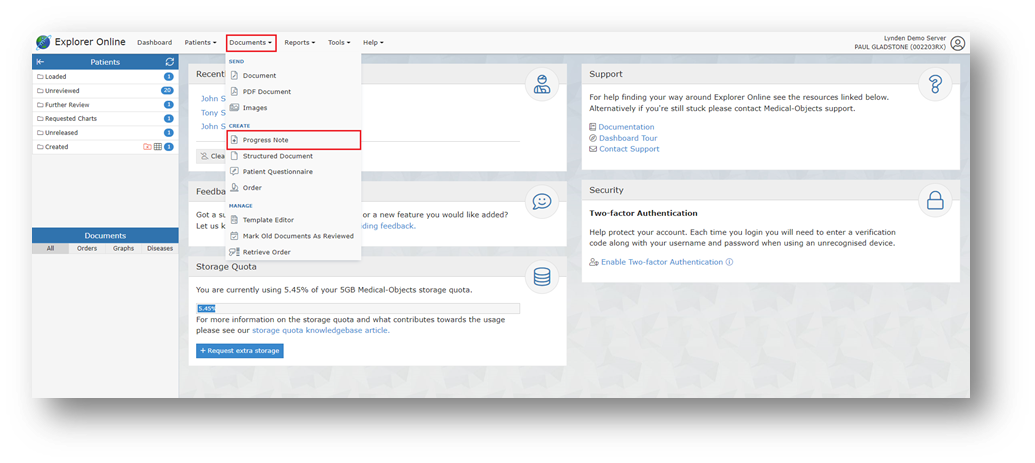
If you don't already have an active patient, you will be prompted to find a patient. Once a patient is selected you will be prompted with the Progress Note window.
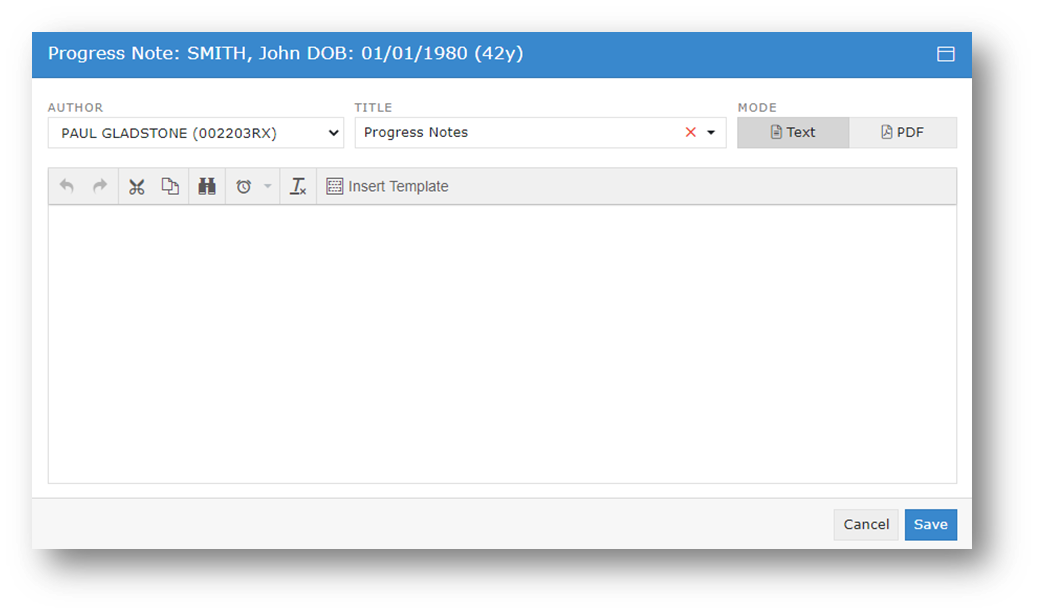
A Progress Note can contain plain text or a PDF document, but not both. Select which document content you'd like to add via the Text or PDF mode buttons in the top right-hand corner.

Tip!
- You can insert a document template by clicking the Insert Template button.
- You can make the Progress Note window bigger by clicking the maximise button. (
 )
)
Using a Structured Document
A collection of dietitian-related assessments has been created and currently exist on Explorer Online as structured documents. To access this feature, open Documents tab in the Navigation Menu then select Structured Document. If this does not appear on your account please contact Helpdesk on (07) 5456 6000.
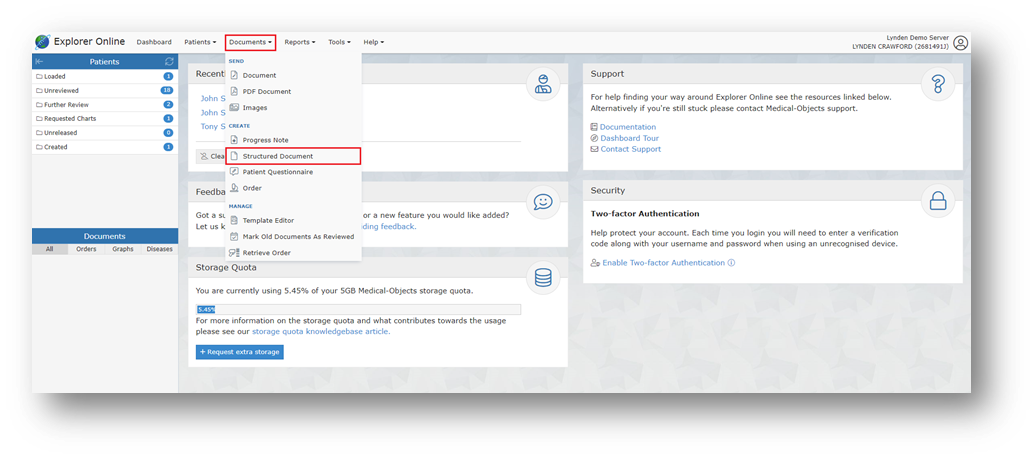
The list of structured documents will load under the heading of Available Archetypes. Choose a structured document for your desired purpose.

The Patient Lookup popup will appear if a patient wasn’t already chosen from the Dashboard. The structured document will load and is ready to be completed. At the bottom of the form there are the options to Reset Template, Revert Changes, Submit or Save Draft.
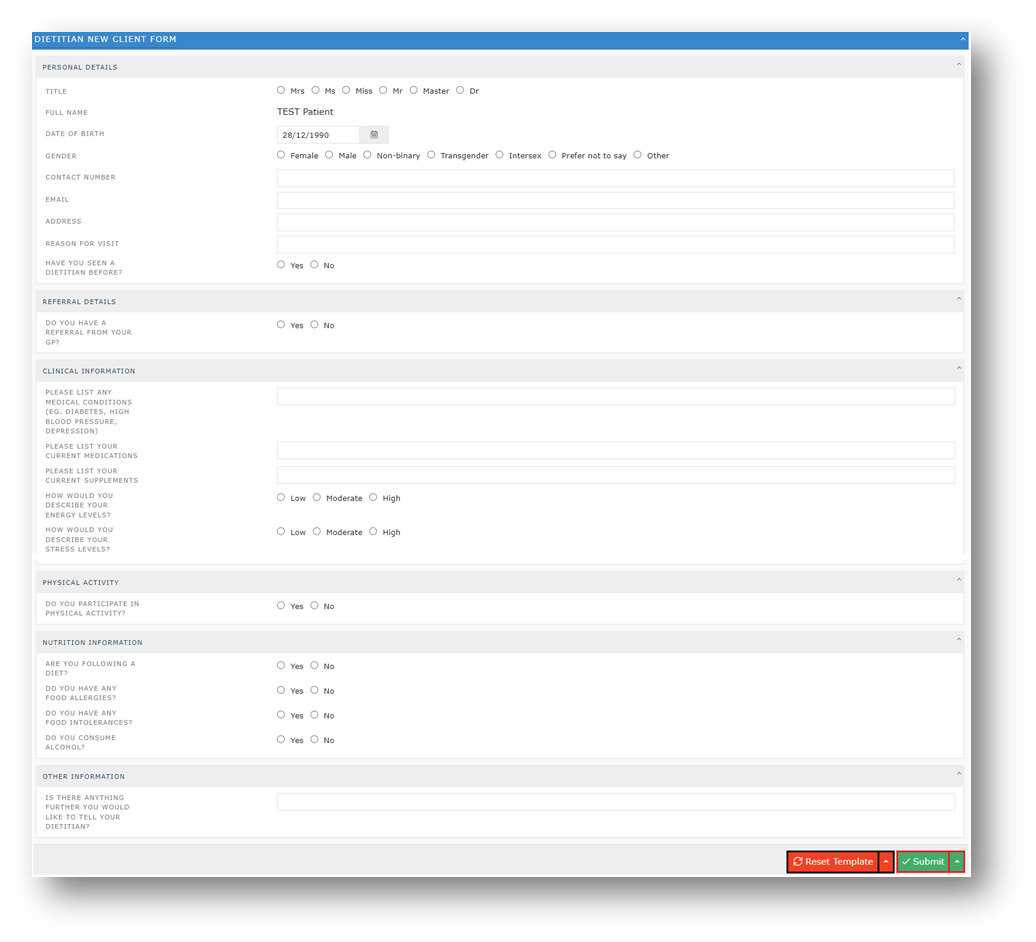
Once the structured document has been submitted, the Send Document popup will appear. The Patient Details will have automatically populated, leaving the Addressing Details and Document Details to be filled out.
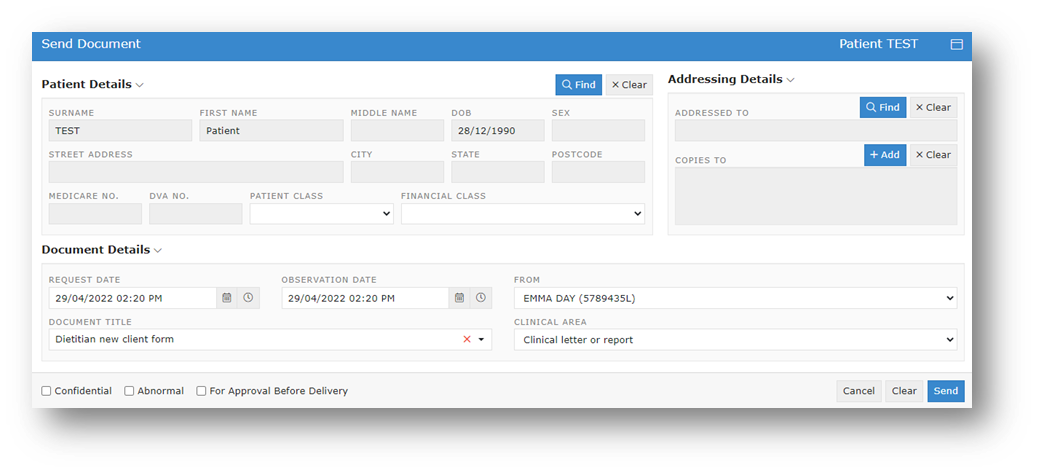
Once the Send button has been clicked the structured document will be added to the patients file and be visible in the Document Sidebar.
Structured documents are assessments or questionnaires that can help with clinical decisions. These forms can be customised to meet your practice needs. If interested please get in contact with our sales team here.
Examples of existing dietitian-related structured documents include:
- New Client Form
- Malnutrition Screening Tool (MST)
- Fluid Loss
- Estimated Fluid Requirements
- Estimated Protein Requirements
- Basal Metabolic Rate (BMR), Resting Energy Expenditure (REE) and Estimated Energy Requirements (EER)
- Nutrition Risk Screening (NRS) 2002
- Subjective Global Assessment (SGA)
- 24 Hour Recall
- Food and Fluid Chart
Using a Patient Questionnaire
The Patient questionnaire function is similar to structured documents. It is ideal for gathering information before the appointment. The patient can fill out the questionnaire or assessment online via their phone, table or computer and the results are automatically added to their patient file. To access this feature, open Documents tab in the Navigation Menu then select Structured Document. If this does not appear on your account please contact Helpdesk on (07) 5456 6000.
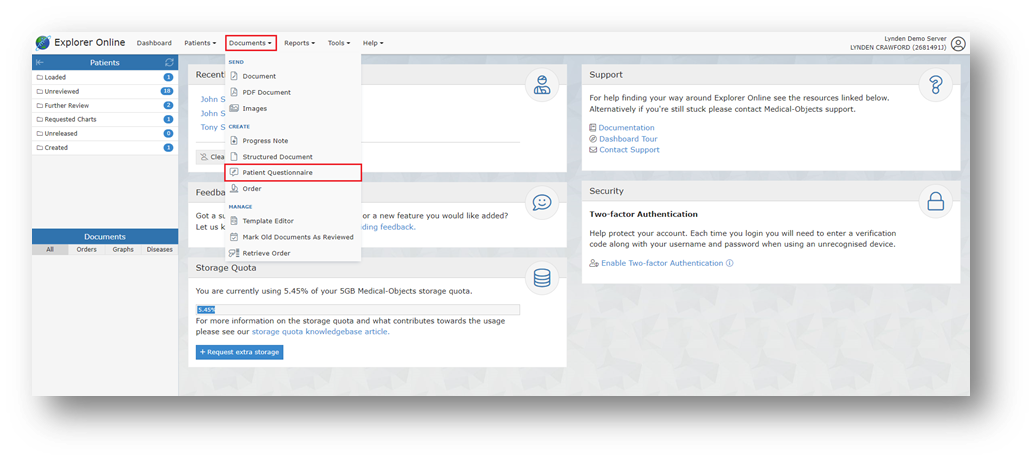
The Create Patient Questionnaire popup will appear and will require the Family Name, Given Name and Date of Birth to be filled in.
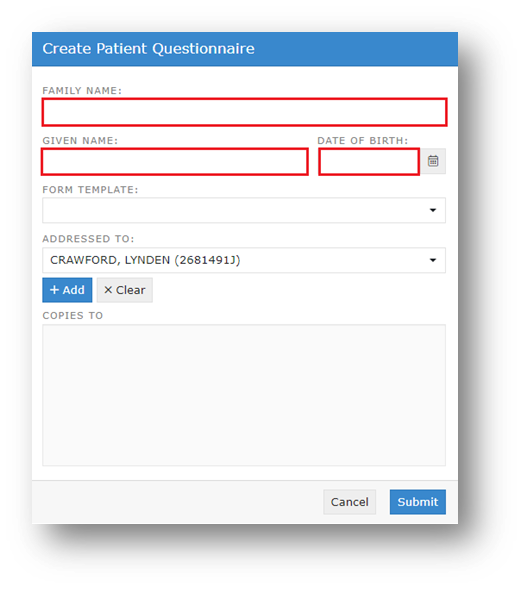
Choose the questionnaire or assessment from the Form Template drop down menu and click Submit.
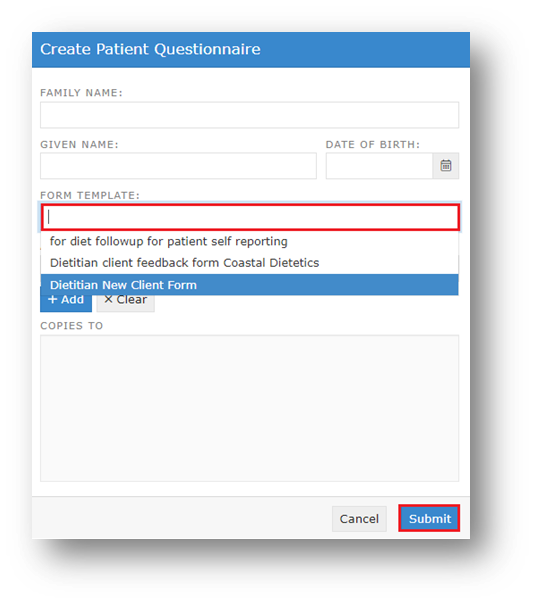
Once submitted, a QR code will appear which allows the patient to scan and access the form directly or the URL link provided can be distributed to the patient for them to access. You are able to create another Patient Questionnaire from the same popup or close if done with the feature.
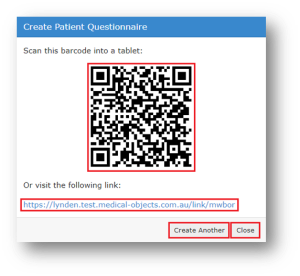
The QR code and the URL link will display the form on the patient’s device ready to be filled out. Once completed, the patient is able to Reset Template, Revert Changes, Submit or Save Draft.

Once the patient has submitted the form, it will be added their file and they will be displayed the following screenshot.
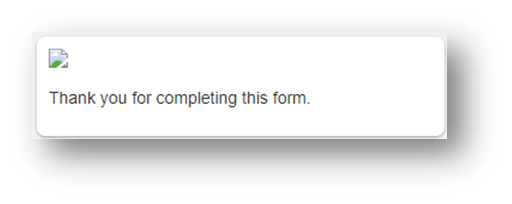
Patient questionnaires are forms or questionnaires that can help with gathering information and informing clinical decisions prior or after the appointment. These forms can be customised to meet your practice needs. If interested please get in contact with our sales team here.
Examples of existing dietitian-related patient questionnaires include:
- New Client Form
- Feedback Form
- Self-Reporting Follow Up
- Food Diary - 24 hour recall
Document Template Editor
To get to the Document Template Editor, you can click Documents → Template Editor (Under manage). A screen should show up with text editors, and a sidebar.

After clicking that button, the screen below will appear.
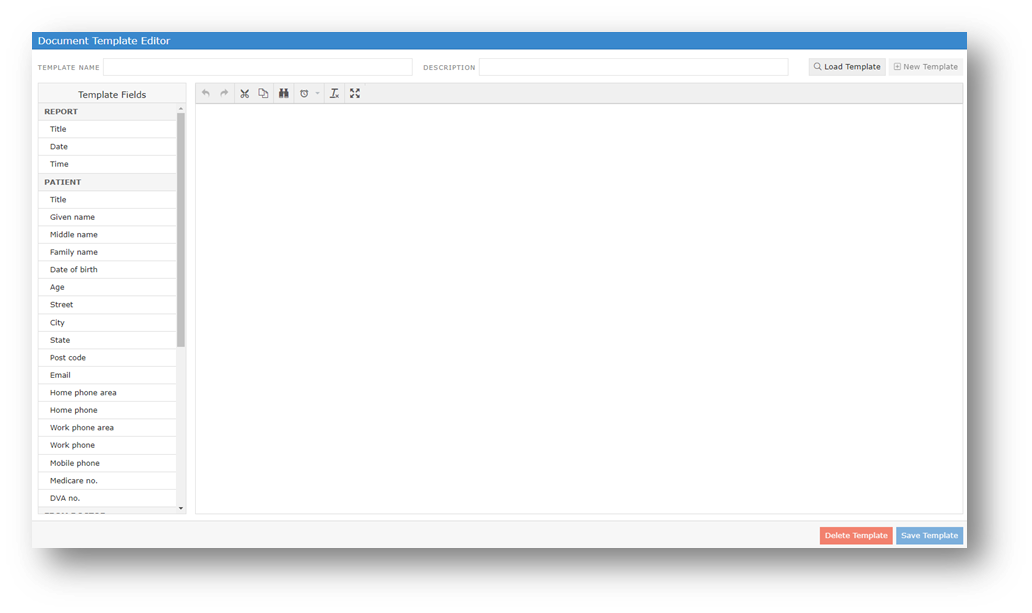
Creating a Template
A document template must have a template name, description and some content.
Template Name
The template name is what you'll see on your end to identify each template. You should call it something descriptive, but also keep it concise.
Description
The description will show as a sub header when selecting the template. This is generally longer than the Template name and can help when you have a few very similar template names.
Content
The content is what will automatically be generated into the document when you select a template. You can see on the left of the template editor a Template Fields, these are special fields, that when you import the template into your document, they will fill out with the details you've included.
For example, if you have selected a patient named "John Doe", then the Given Name template field will be "John" and the Family Name field will be "Doe". You can also write plain text with no template fields.
Submitting a Template
Once you have filled out the required fields, you can create the template by clicking the Save Template button, highlighted in the below screenshot.
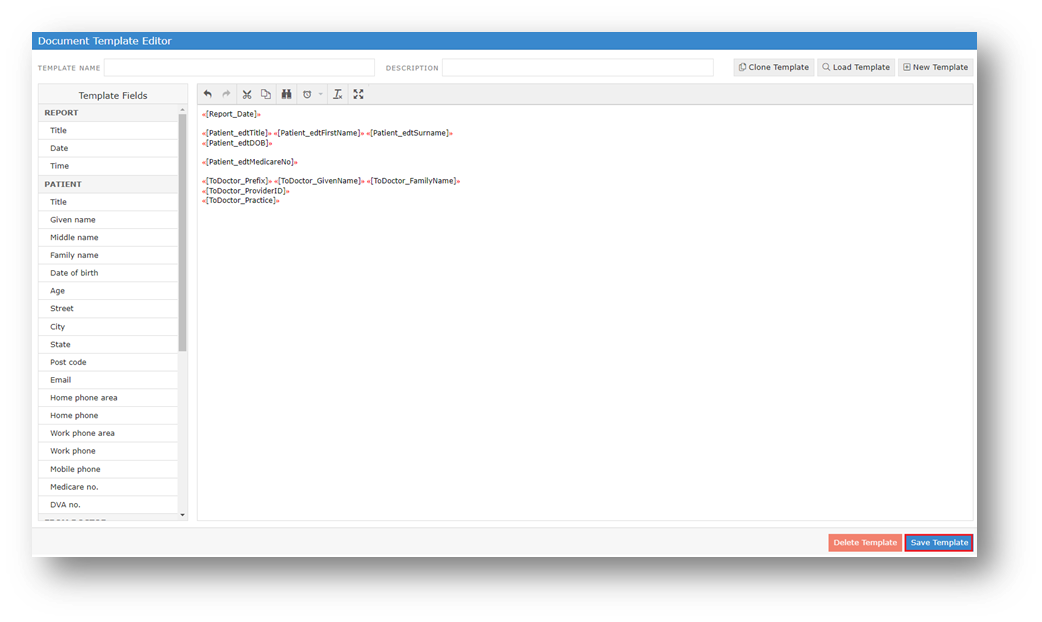
Editing an Existing Template
To edit an existing template, you need to:
- Load a template
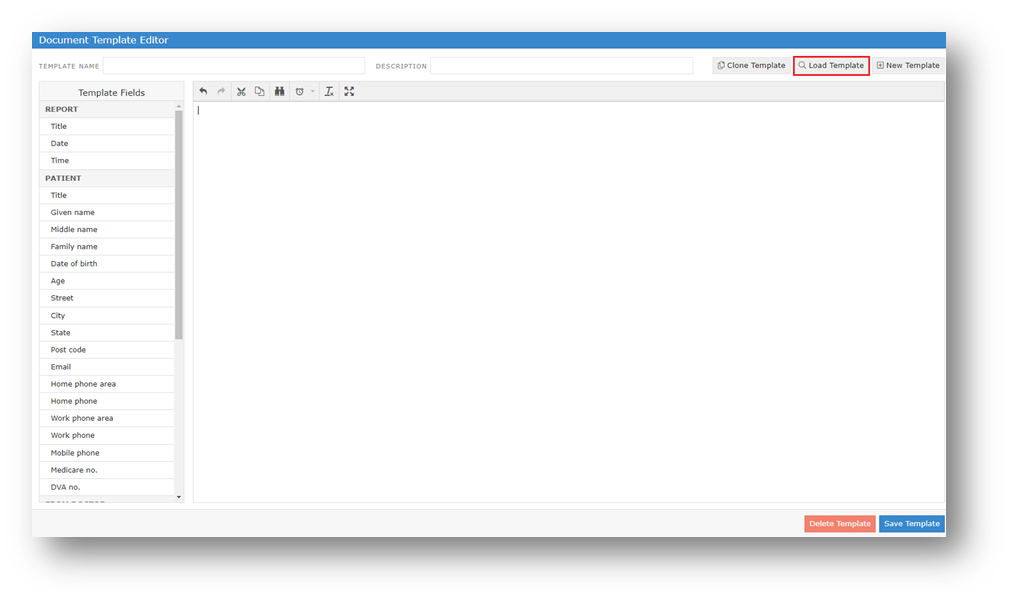
- Select a template from the preceding screen by clicking on the desired template, and clicking Load in the bottom right
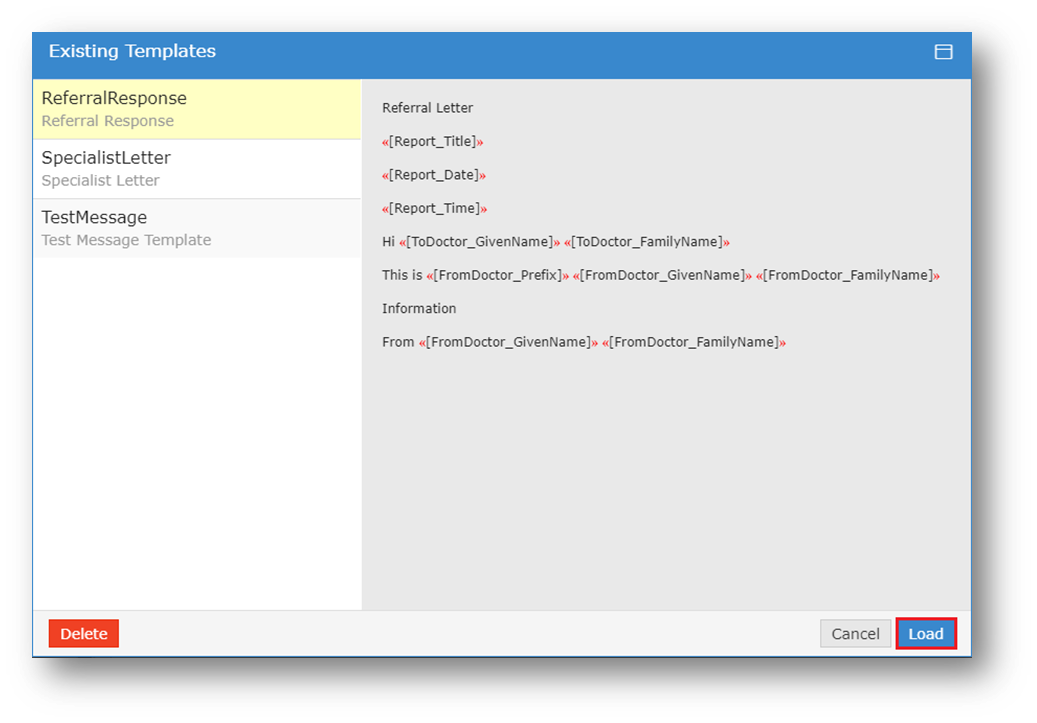
- Make any changes that you wish to make, and then click the Save Template button in the bottom right, exactly how you would save a new template.
Deleting a Template
Click the Load Template button
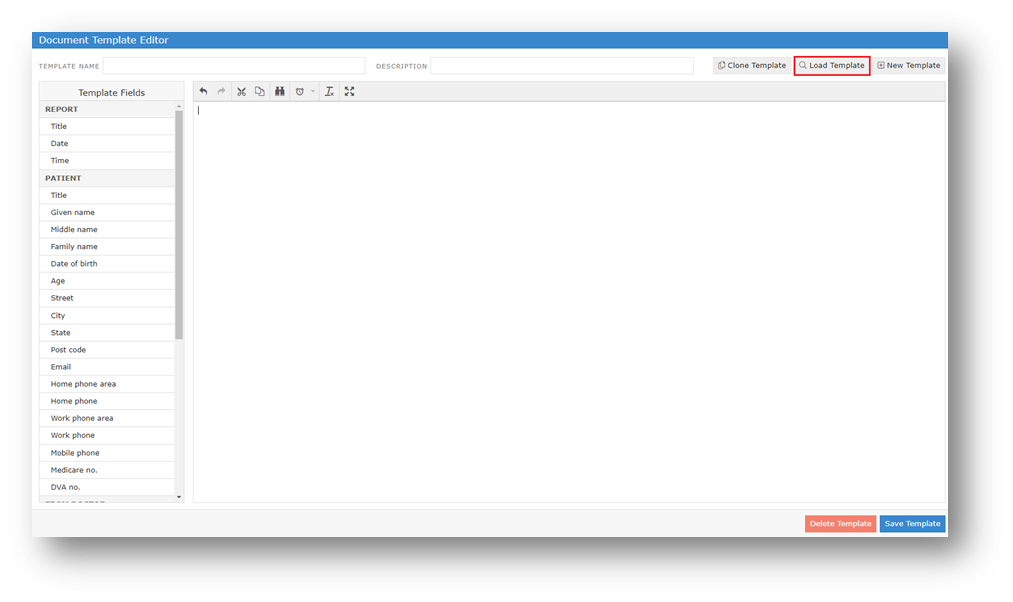
Then, select the template you wish to delete, and then click the Delete button in the right-hand corner of the new screen
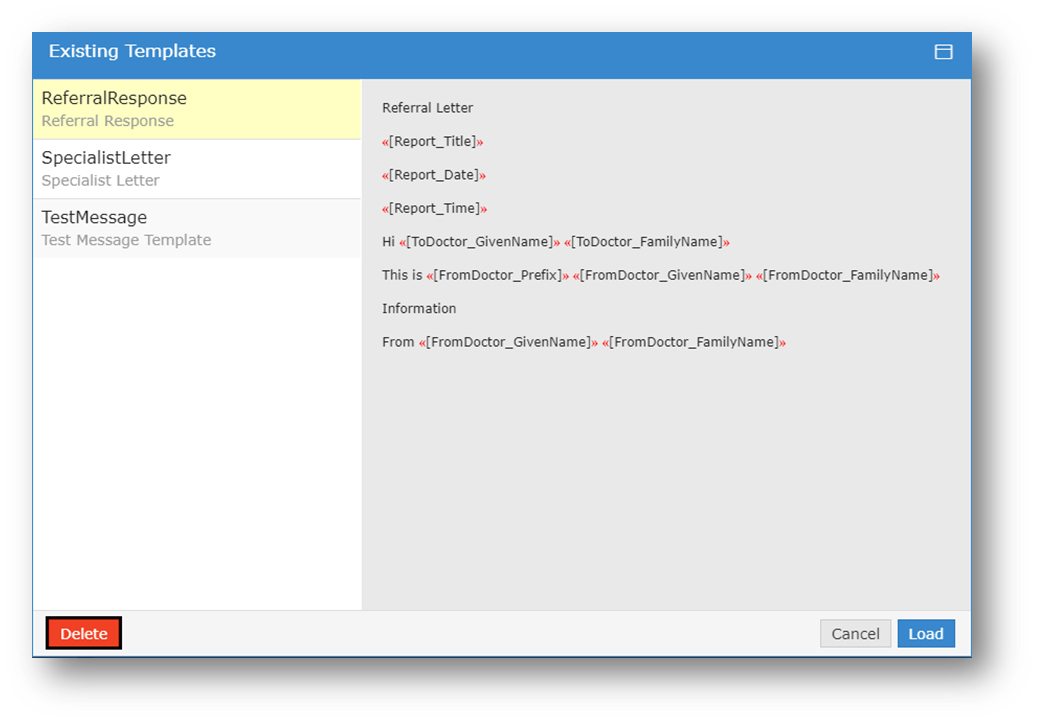
Viewing Reports
Activity Report
The Activity Report allows you to view the transaction history of both incoming and outgoing documents. You can access the Activity Report via the Reports tab in the navigation menu.
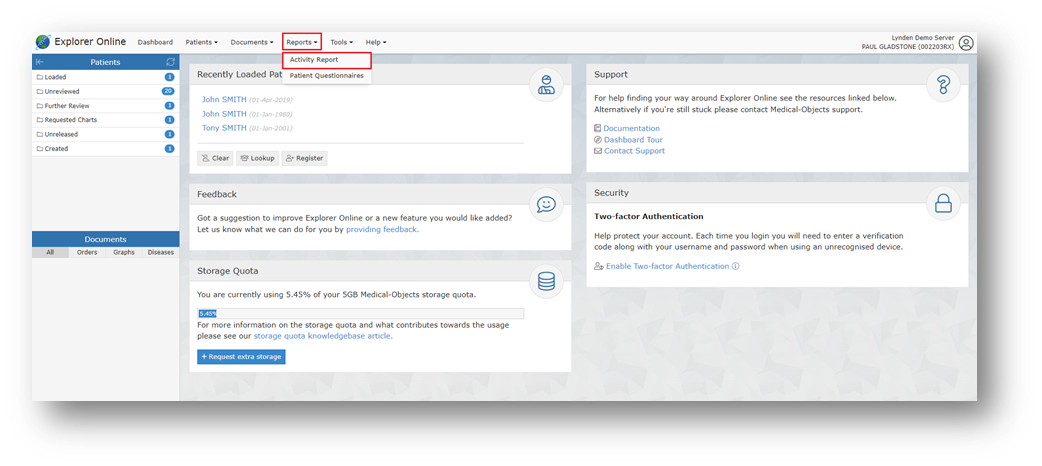
After selecting Activity Report, you will be presented with a window listing the report filtering options available. These will help you narrow the report down to only the documents you're interested in. By default, the filter options will show the current daily activity. The date range can be adjusted via the calendar icon.
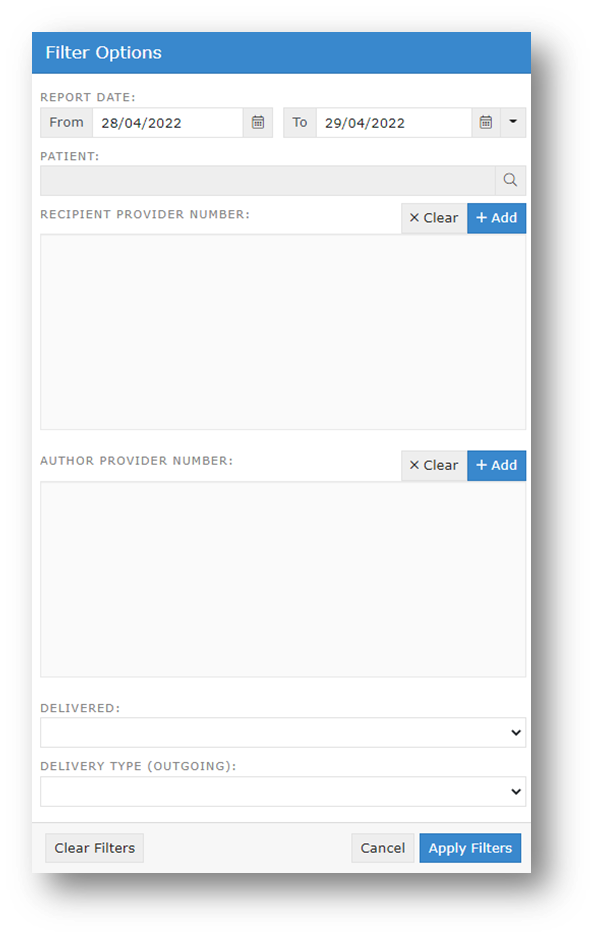
Once the filters have been applied, the following screen will appear. The orange box indicates the active filters and can be edited when clicked.

Tip!
- You can hide or show columns via the grid menu (
 ) which can be accessed by clicking the far-right button.
) which can be accessed by clicking the far-right button. - You can drag to re-order columns. The position of columns will be remembered.
- You can reset the grid layout by choosing Reset View from the grid menu.
Understanding the Report
Date | The date the document was created. |
Patient | Patient name. SURNAME, First name (Date of Birth). |
Recipient | The provider the document was addressed to. |
Report Title | The document title. |
Author | The provider that authored the document. |
To Practice | The server name of the practice that the document was sent to. This is generally the practice name. |
Status | The status of the document. The most common are:
|
Delivery Type | The software of the recipient that received the document. |
Delivered | This is a timestamp for when the document was delivered. It does not necessarily mean that the document has been viewed or reviewed - only that it has been delivered. If this field is blank then the document has not been delivered. |
Reviewed | The document has been marked as reviewed at the receiver's end. This column will only be populated if the receiver's Delivery Type is EQUATORDXTRAY. If not then it's best to look at the ACK column for an indication if the document has been acknowledged. |
ACK | This column allows you to know whether or not the document has been acknowledged. To see what each icon in this column means; refer to the ACK Legend that can be found in the top right. Hover your mouse over each icon for a description.
|
View | Clicking the icon in this column will display the document. |
Filler Order Number | Unique identifier of the message. Can be based on the laboratory code or for Medical Objects generated reports it's a globally unique identifier (GUID/UUID). |
Viewing Documents in the Report
You can view a single document by clicking on the view document icon (![]() ) in the View column of the grid. This will open the document in the document viewer window.
) in the View column of the grid. This will open the document in the document viewer window.
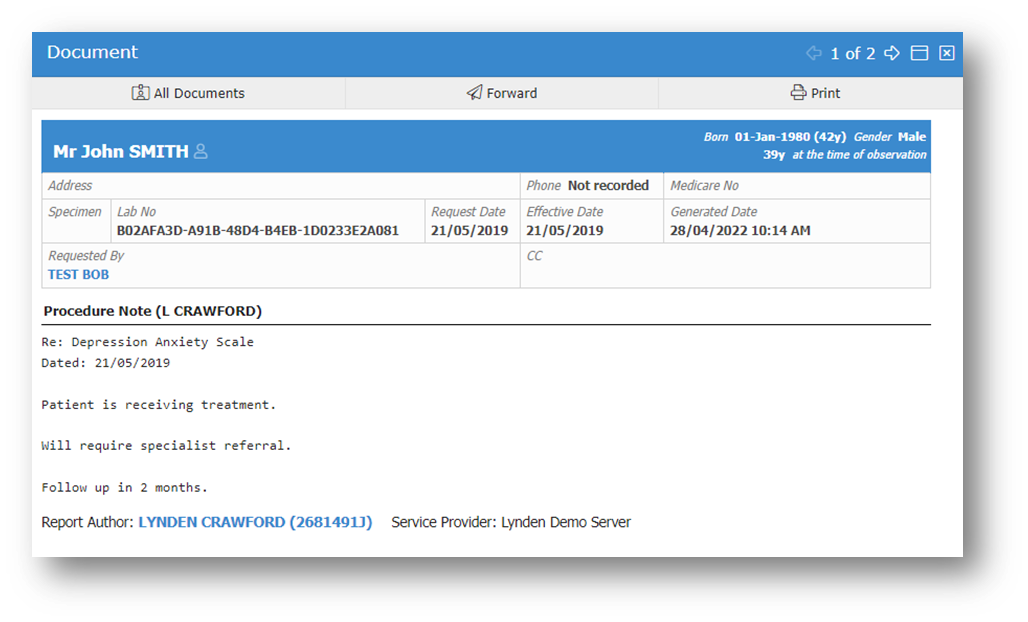
From this window you can perform various actions on the single document such as print, forward or loading the patient file via the All Documents button. You can also navigate to other documents via the back and forward buttons in the top right.
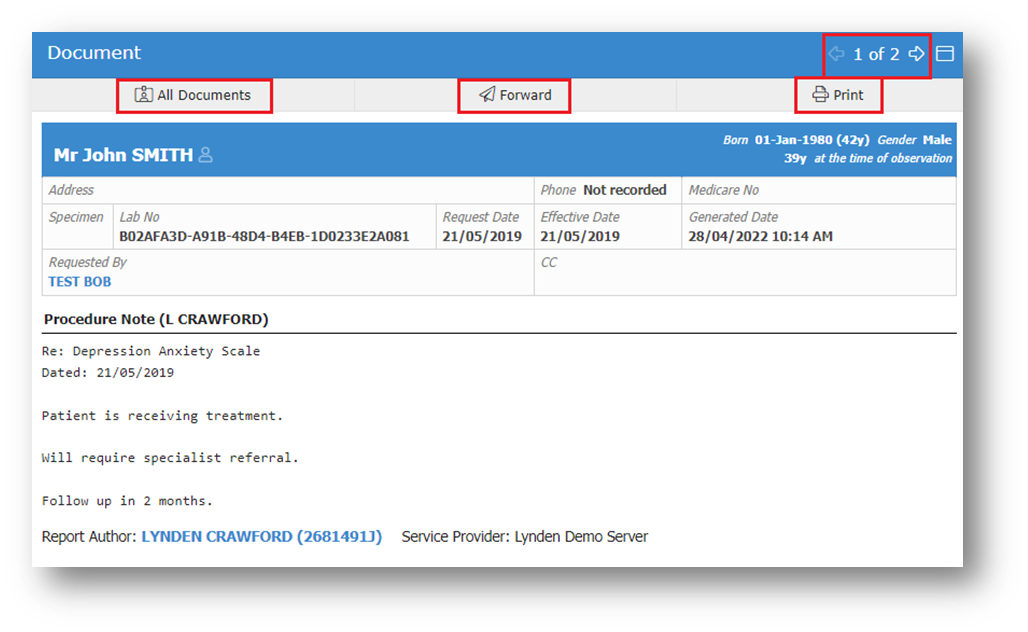
Bulk Actions
You can select multiple documents in the grid and then perform an action on the selection. Currently the bulk actions available are;
- Printing
- Forwarding
- Exporting to CSV (this exports the transaction details and not the document itself, useful for auditing purposes)

Patient Questionnaire Reports
The Patient Questionnaires report enables you to view the history of created questionnaires, forms and assessments and if they have been completed or to re-access the QR code and link.
This function is found in the Reports tab on the navigation menu.
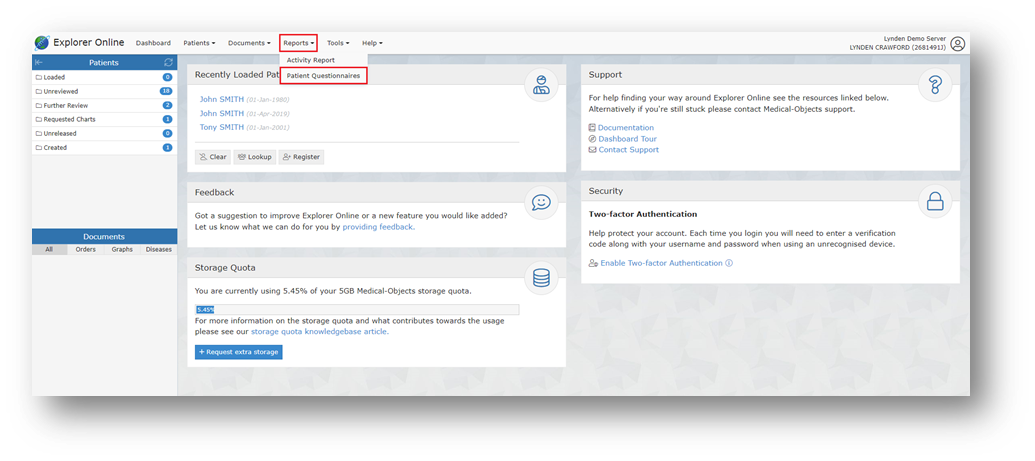
After selecting Patient Questionnaires, you will be presented with a window listing the report filtering options available. These will help you narrow the report down to only the documents you're interested in. The date range can be adjusted via the calendar icon. Click Apply Filters to access the report.

Once the filters have been applied, the following screen will appear. The orange boxes indicate the active filters and can be edited when clicked.

The three icons in the top right-hand corner are used to Create New Patient Questionnaire, Refresh Report and View/Edit filters.
Understanding the Report
Patient | Patient name (SURNAME, First name) |
Date of Birth | Patient date of birth (year, month, date) |
Date Created | Date that patient questionnaire was sent to patient |
Archetype | Type of patient questionnaire sent to patient |
Start Date | Date that patient started to complete questionnaire |
End Date | Date that patient submitted questionnaire |
Date Satisfied | Indicates if the questionnaire was completed (will show the date that the questionnaire was started by the patient) or Not Satisfied (meaning the patient has not submitted their form). |
View | The View column holds the QR code icon and when selected the original QR code and link will appear. |
Cancel | The Cancelled column has a red icon that when selected, you are able to cancel the sent patient questionnaire. Once a patient questionnaire has been cancelled it will disappear from the list. You are only able to cancel if the form hasn’t been submitted by the patient. |
Delivery Count Reports
The Delivery Counts report enables you to view the history of where and how many correspondences you have sent to practices through Explorer Online.
This function is found in the Reports tab on the navigation menu.

After selecting Delivery Counts, you will be presented with a window listing the report filtering options available. These will help you narrow the report down to only the dates you're interested in. The date range can be adjusted via the calendar icon. Click Apply Filters to access the report.
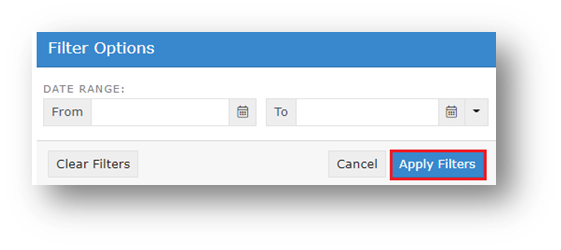
Once the filters have been applied, the following screen will appear. The orange box indicates the active filters and can be edited when clicked.
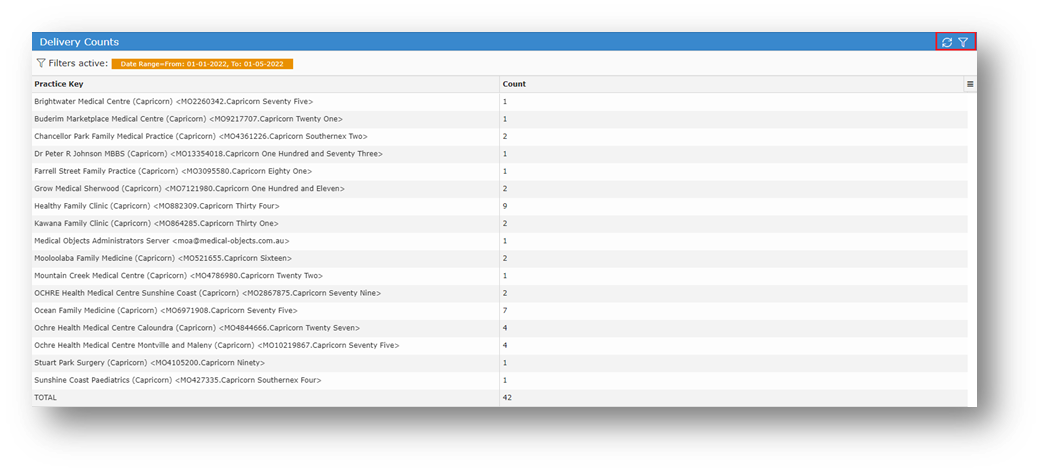
The two icons in the top right-hand corner are used to Refresh Report and View/Edit filters.
Understanding the Report
Practice Key | Practice name |
Count | The number of times correspondence has been sent to a practice. |
Total | The number of times correspondence has been sent. |
My Health Record
To access a patient’s health summary from My Health Record, ensure the patient’s name (First and Surname), Date of Birth, Sex, Medicare, DVA or IHI number is entered.
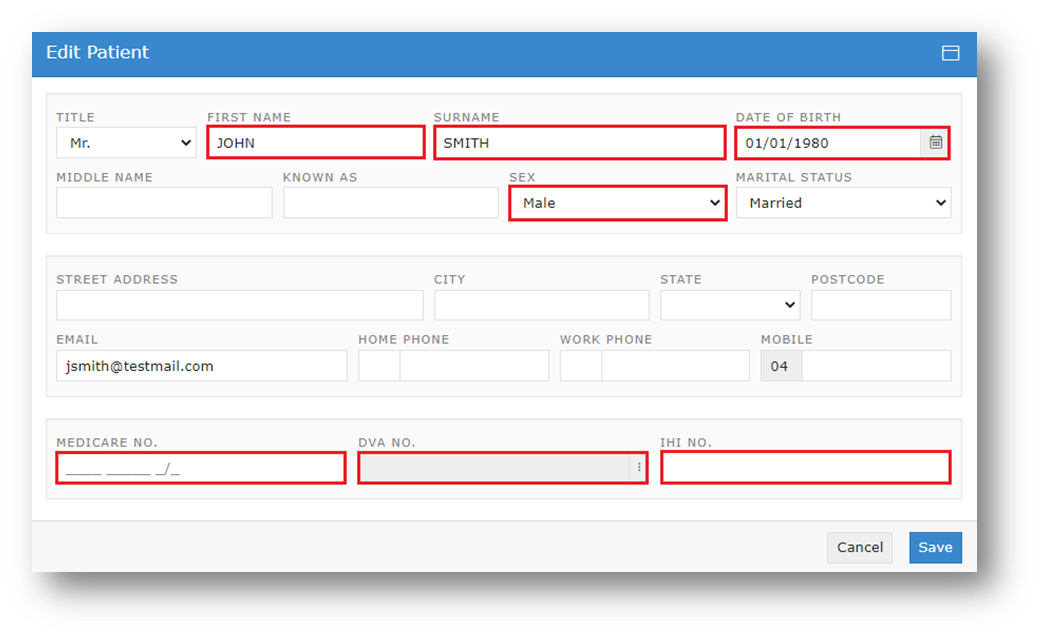
Note: Your practice must be registered with HPI-O for users to view a patient’s My Health Record summary.
Once these details are entered and you are registered, a coloured heart will appear next the patient’s name in the sidebar.
- Orange heart: will appear if they do not have a My Health Record.
- Red heart: will appear if their IHI number needs to be revalidated.
- Green heart: will appear if that patient has a My Health Record.
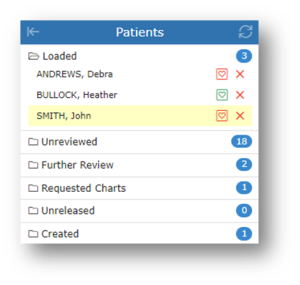
You are able to access My Health Record by clicking on the green heart icon.
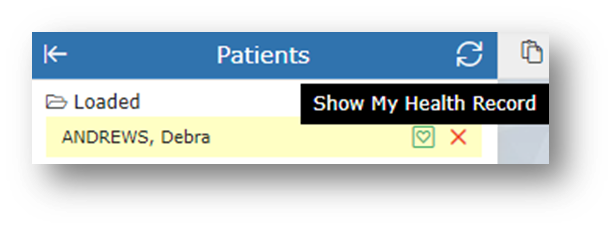
The patient’s past medical history if uploaded to My Health Record will appear ready for perusal.
By clicking on the tabs along the top you are able to navigate the available documents in Health Record Summary, Pathology Report and Diagnostic Imaging.
Use the Document Filters to help find and sort for the necessary information and adjust the dates in the Documents From tab. Click View Documents to view the filtered documents.
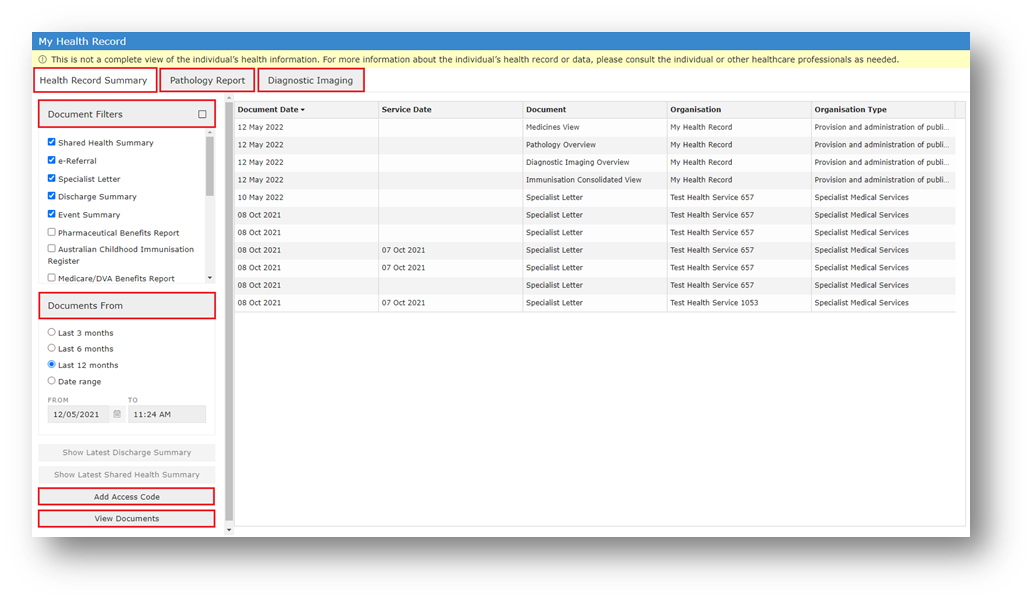
Note: You may need an access code if locked by the patient. You are able to get emergency access but will be recorded on the eHealth audit log and the patient will be notified.
Click on the desired document to view the patients’ My Health Record.
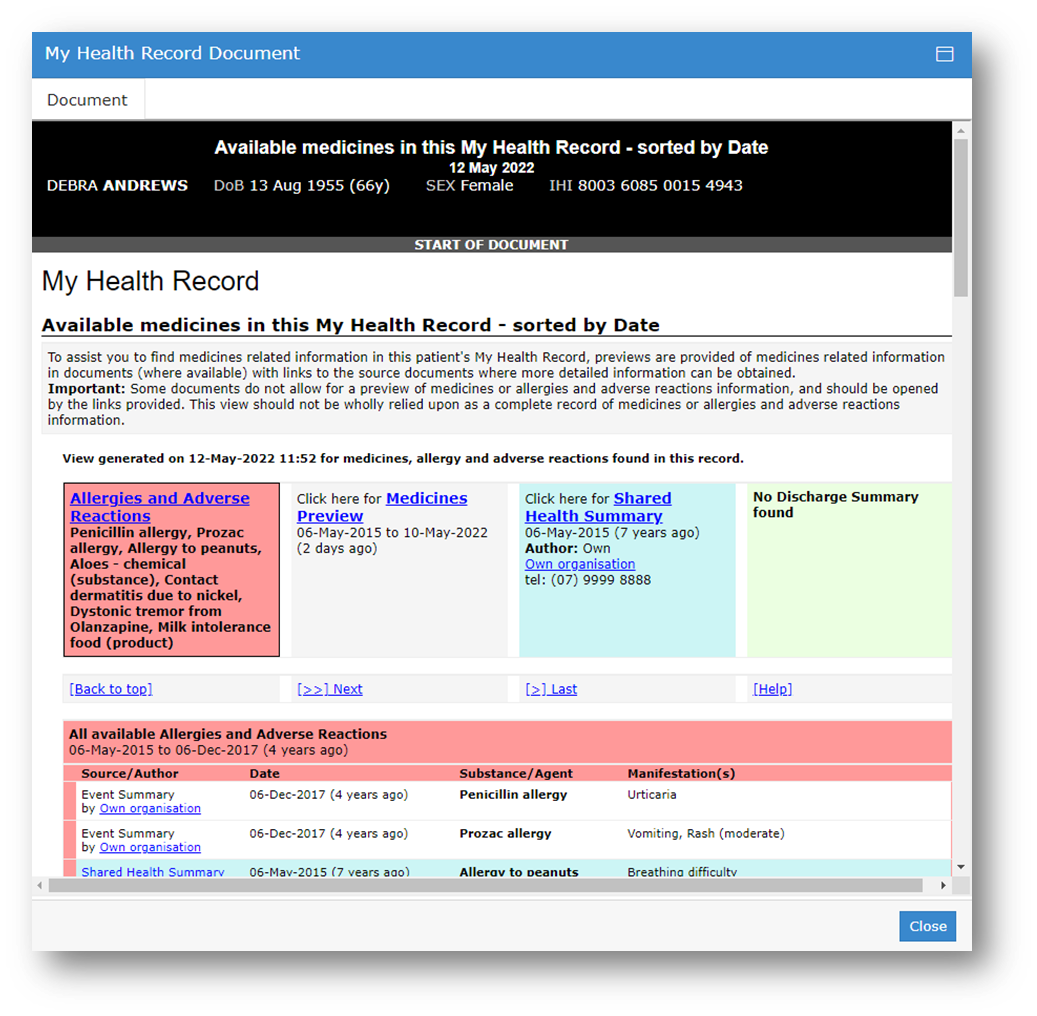
- No labels






